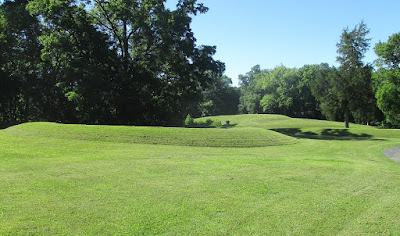The view from the top, facing east and slightly north, shows a bit of a residential neighborhood across the street from the mound.
The rock in the front of the mound includes a plaque.
I left the Columbus area and found my way to Cedarville. Less than a mile west of downtown Cedarville, along U.S. highway 42, is Petersen Park, which includes the Williamson Mound. A trail about one half mile long leads you up to the mound. The Shrum and Williamson Mounds are believed to have been constructed by Indians of the Adena culture.
After leaving Cedarville, I continued southward through Hillsboro to the Serpent Mound, which I first visited in 2002. I also made a brief stop there about a year ago, but decided to forego visiting the place due to lightning storms in the area. This time, the weather was sunny and clear. Here is what you might see if you approach the Serpent Mount from its southern end.
If you climb up the 35-foot-high observation tower, the mound might look like this.
Here's a shot from the northern part of the mound, looking back toward the tower.
Finally, here's a shot showing the tower and one of the serpent's bends.
Archaeologists aren't sure who built the Serpent Mound. Some say that it was built by the above-mentioned Adena Culture, while others attribute it to the more recent Fort Ancient Culture. Read more at The Great Serpent Mound, Arc Of Appalachia, Atlas Obscura and the Ohio History Connection (the current name of the above-mentioned Ohio Historical Society). For a look at the controversy about which culture should get the credit for this mound, go to Indian Country Today, which admittedly favors the Adena Culture.









No comments:
Post a Comment